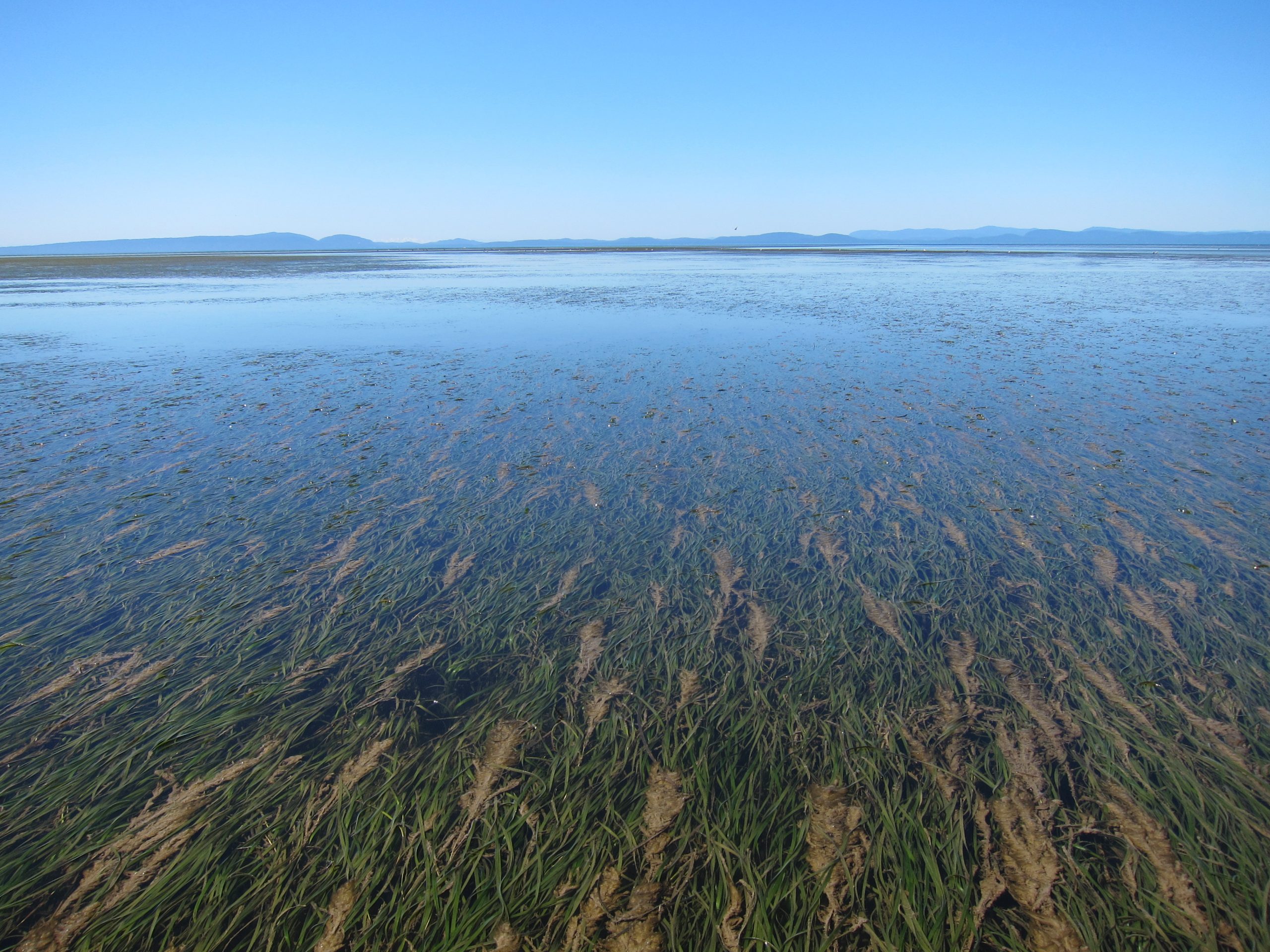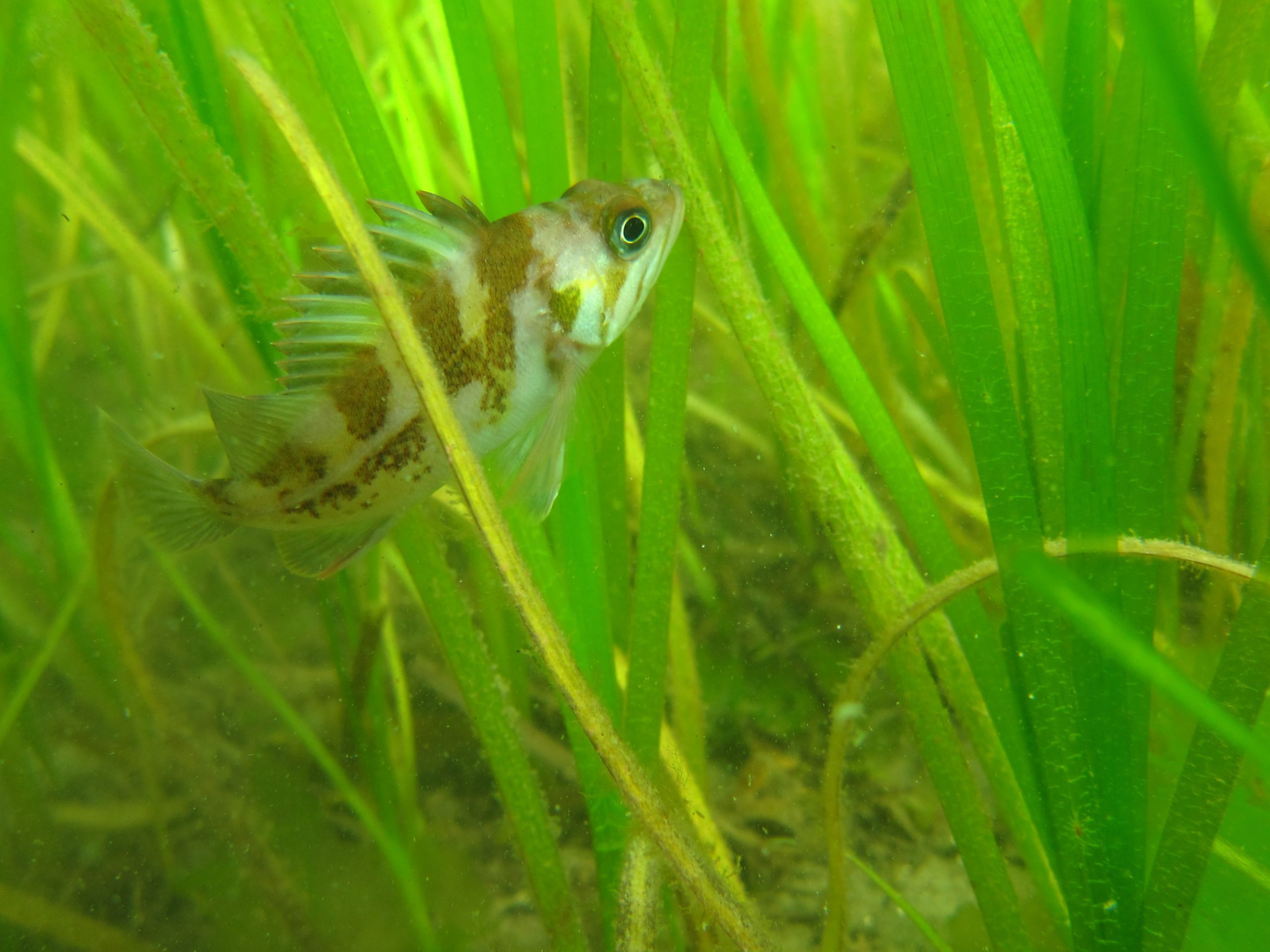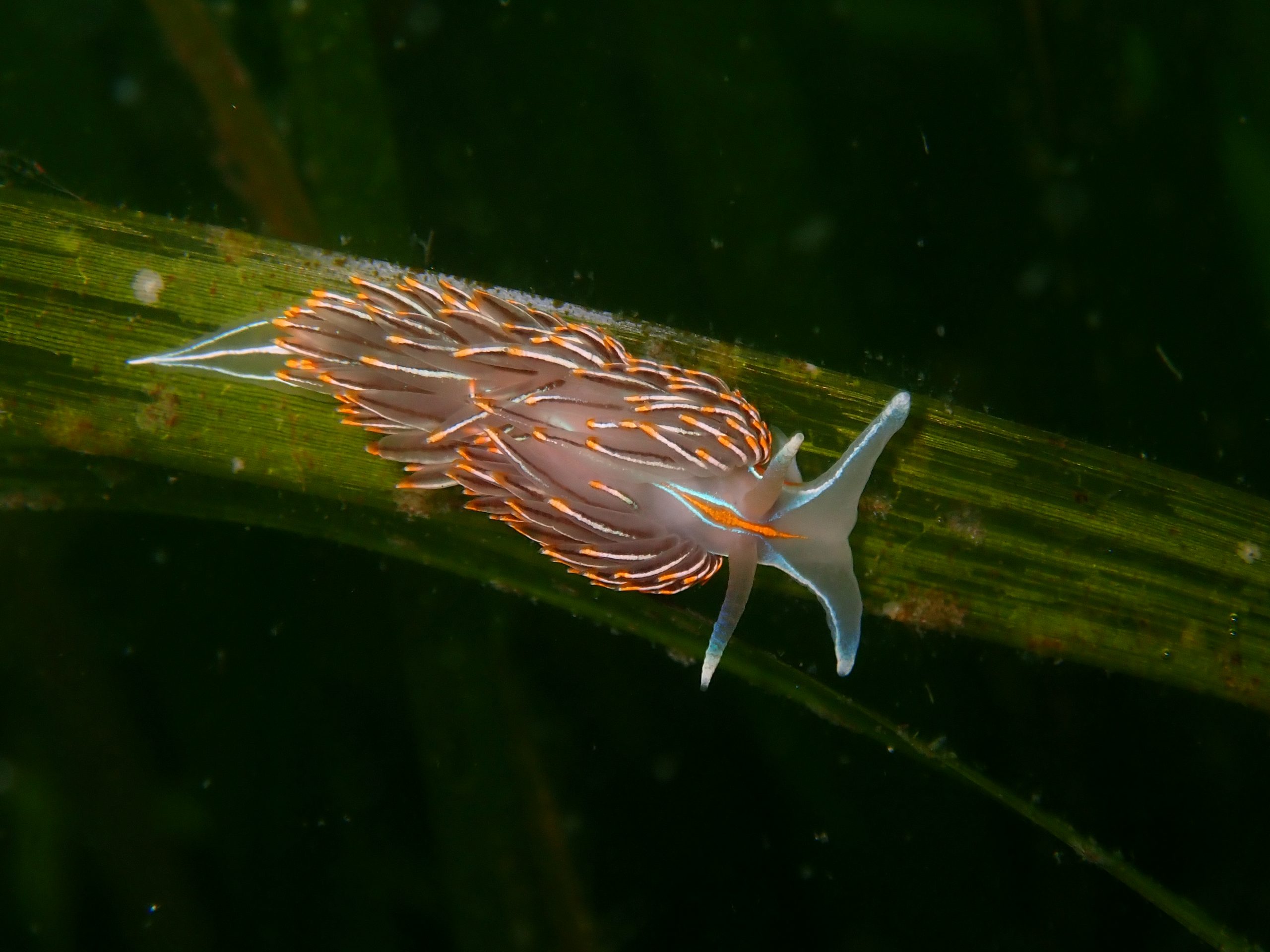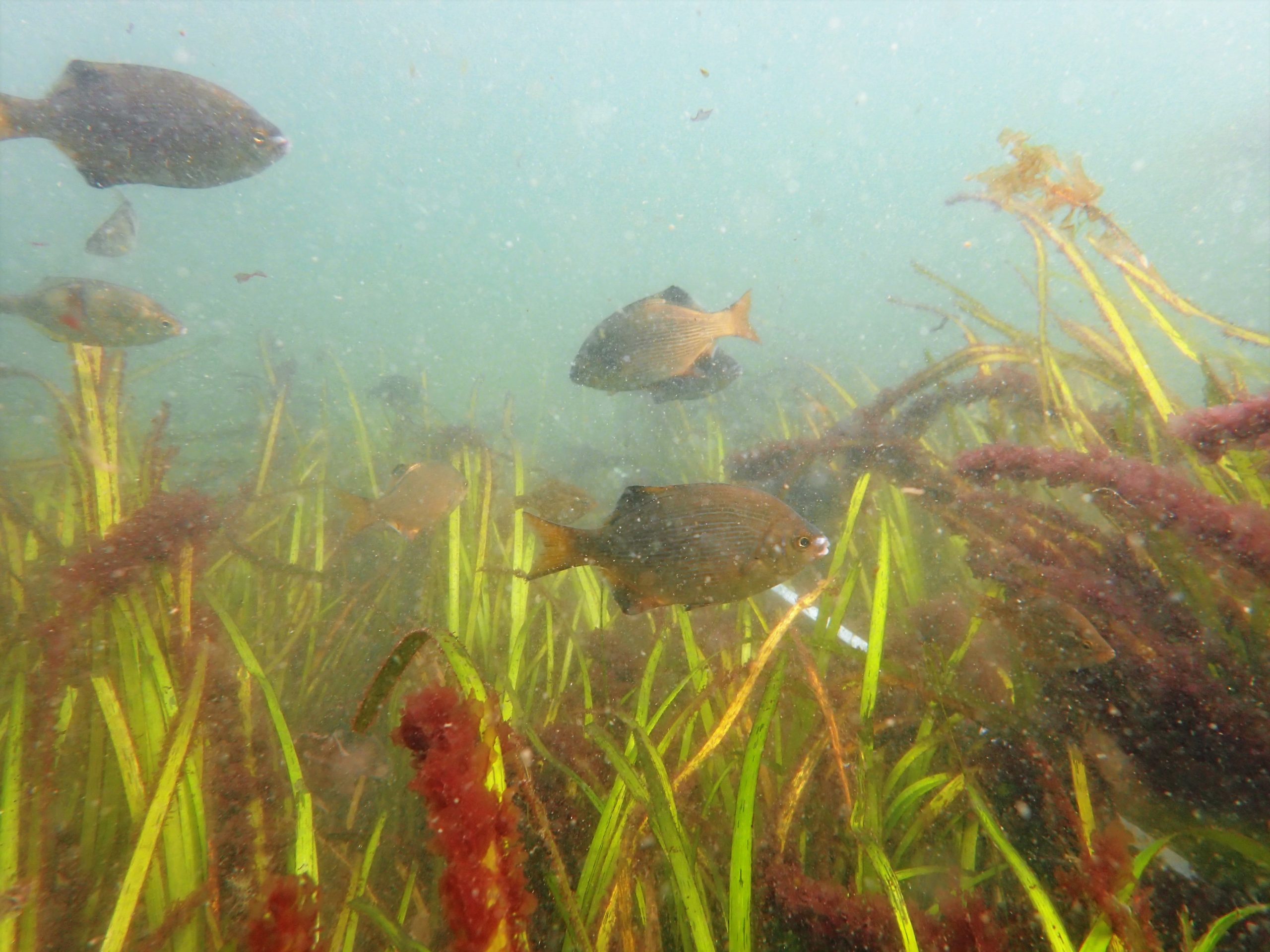Eelgrass Communities
By Taeven Lopatecki and Quynn Stafford
Peer below the shallow water in one of the protected bays of the Pacific Northwest coast, and chances are you will discover an enchanting underwater meadow of emerald stalks waving back. Seagrass meadows lie at the wide mouths of estuaries and in the grey silts and sands of the intertidal and foreshore. This beautiful and biodiverse ecosystem hosts a great diversity of life. From the sub-tropics in Baja California, Mexico, to the Arctic in Alaska, Canada, and Greenland, the most common species of seagrass in North America is the eelgrass Zostera marina. Along the west coast of North America, this native species is also found alongside the introduced dwarf eelgrass, Z. japonica, which originated from Northeast Asia (1).
Wading deeper into these seagrass meadows, the richness of life here slowly reveals itself. Seagrass is a foundation species that creates a complex habitat, thereby providing shelter for a diverse number of species. Eelgrass meadows form critical nurseries for many species’ young, including juvenile salmon and flatfish, and serve as a spawning ground for herring (2,3). They also provide rich foraging habitat for numerous invertebrates and many larger creatures, including heron and geese (4,5).
Other functions of seagrass meadows include filtering excess nutrients from the nearshore environment, preventing shoreline erosion, and storing carbon (3). Carbon stored in seagrass meadows, along with salt marshes and mangroves, is referred to as “blue carbon” (6). These coastal habitats play a major role in carbon sequestration, storing about twice the average amount of organic carbon per hectare as terrestrial soils (7). Protection and conservation of these areas is thus important not only for biodiversity and marine species health, but also for worldwide climate change mitigation. Indeed, seagrass meadows comprise 10–18% of all carbon buried in the ocean (8).
Seagrass ecosystems are easily damaged by a range of factors. Coastal development is a top concern, caused primarily by underwater building, dredging, and intertidal hardening which lead to habitat loss (3,9). Hardening is the increasing use of stone and cement walls to prevent property damage and erosion, without considering the buffer against erosion that is naturally provided by seagrass and healthy nearshore ecosystems. Decreasing water quality caused by pollution and other runoff leads to an excess of nutrients and lack of oxygen, diminishing the health of seagrass meadow inhabitants (3,9). These stressors, combined with warming ocean temperatures, and the monospecific nature of seagrass meadows, have led to another challenge: the spread of seagrass wasting disease across the Pacific Northwest (10). This disease is caused by the protist Labyrinthula zosterae, which destroys seagrass tissue leading to a decrease in habitat (11). Like coral reefs, mangroves, and tropical rainforests, seagrass meadows are among the most threatened ecosystems on the planet (9). Ten of 72 seagrass species worldwide are at risk of extinction, while three others are considered endangered (12).
Beyond their visual ties to terrestrial meadows, seagrass ecosystems provide a solid link between the ocean and the land. These tidal meadows are nourishing places where sunlight, freshwater, saltwater, and sediments combine, giving rise to food webs that allow life of all kinds to flourish, from microscopic bacteria and algae to larger animals like crabs, fishes, birds, and bears (13). Indeed, the interconnectivity emergent in these places extends well beyond the ocean’s physical borders, making seagrass meadows vital to the health of our coastal ecosystems




Bibliography
1. Harrison PG. Spatial and temporal patterns in abundance of two intertidal seagrasses, Zostera americana den hartog and Zostera marina L. Aquat Bot. 1982;12:305–20.
2. Haegele CW, Schweigert JF. Distribution and Characteristics of Herring Spawning Grounds and Description of Spawning Behavior. Can J Fish Aquat Sci [Internet]. 1985 Dec 19 [cited 2016 Dec 7];42(S1):s39–55. Available from: http://www.nrcresearchpress.com/doi/abs/10.1139/f85-261
3. Orth RJ, Carruthers TJB, Dennison WC, Duarte CM, Fourqurean JW, Heck, Jr. KL, et al. A global crisis for seagrass ecosystems. Bioscience [Internet]. 2006 [cited 2016 Nov 1];56(12):987–96. Available from: http://bioscience.oxfordjournals.org/cgi/doi/10.1641/0006-3568(2006)56[987:AGCFSE]2.0.CO;2
4. Hughes AR, Stachowicz JJ. Genetic diversity enhances the resistance of a seagrass ecosystem to disturbance. Proc Natl Acad Sci U S A [Internet]. 2004 Jun 15 [cited 2017 Jan 26];101(24):8998–9002. Available from: http://www.ncbi.nlm.nih.gov/pubmed/15184681
5. Huang AC, Essak M, O’Connor MI. Top-down control by great blue herons Ardea herodias regulates seagrass-associated epifauna. Oikos [Internet]. 2015 Nov [cited 2017 Jan 20];124(11):1492–501. Available from: http://doi.wiley.com/10.1111/oik.01988
6. Nellemann C, Corcoran E, Duarte CM, Valdes L, DeYoung C, Fonseca L, et al. Blue carbon: the role of healthy oceans in binding carbon: a rapid response assessment. UNEP/Earthprint; 2009.
7. Fourqurean JW, Duarte CM, Kennedy H, Marbà N, Holmer M, Mateo MA, et al. Seagrass ecosystems as a globally significant carbon stock. Nat Geosci. 2012;5(7):505–9.
8. Kennedy H, Beggins J, Duarte CM, Fourqurean JW, Holmer M, Marbà N, et al. Seagrass sediments as a global carbon sink: Isotopic constraints. Global Biogeochem Cycles [Internet]. 2010 Dec 1 [cited 2021 Jun 9];24(4). Available from: https://agupubs.onlinelibrary.wiley.com/doi/full/10.1029/2010GB003848
9. Waycott M, Duarte CM, Carruthers TJB, Orth RJ, Dennison WC, Olyarnik S, et al. Accelerating loss of seagrasses across the globe threatens coastal ecosystems. Proc Natl Acad Sci [Internet]. 2009 Jul 28 [cited 2016 Nov 1];106(30):12377–81. Available from: http://www.ncbi.nlm.nih.gov/pubmed/19587236
10. Groner ML, Burge CA, Kim CJS, Rees E, Van Alstyne KL, Yang S, et al. Plant characteristics associated with widespread variation in eelgrass wasting disease. Dis Aquat Organ. 2016;118(2):159–68.
11. Muehlstein LK, Porter D, Short FT. Labyrinthula zosterae sp. nov., the causative agent of wasting disease of eelgrass, Zostera marina. Mycologia [Internet]. 1991 [cited 2018 Oct 22];83(2):180–91. Available from: https://www.jstor.org/stable/pdf/3759933.pdf?refreqid=excelsior%3Abe8a5584704e8c20cc68049cbe135785
12. Short FT, Polidoro B, Livingstone SR, Carpenter KE, Bandeira S, Bujang JS, et al. Extinction risk assessment of the world’s seagrass species. Biol Conserv. 2011 Jul 1;144(7):1961–71.
13. Heck KL, Carruthers TJB, Duarte CM, Randall Hughes A, Kendrick G, Orth RJ, et al. Trophic transfers from seagrass meadows subsidize diverse marine and terrestrial consumers. Ecosystems [Internet]. 2008 Nov 23 [cited 2021 Jun 9];11(7):1198–210. Available from: https://link.springer.com/article/10.1007/s10021-008-9155-y
Photos by Emily Adamczyk
We acknowledge that Galiano Island and the waters around it are the shared, asserted, and unceded territory of the Penelakut, Lamalcha, and other Hul’qumi’num speaking peoples, as well as the W̱SÁNEĆ and other SENĆOŦEN speaking peoples. This island is also part of the ceded territory of the Tsawwassen First Nation. These relationships with the land have existed since time immemorial and it is with gratitude and respect that we learn, work, play, and live here.
